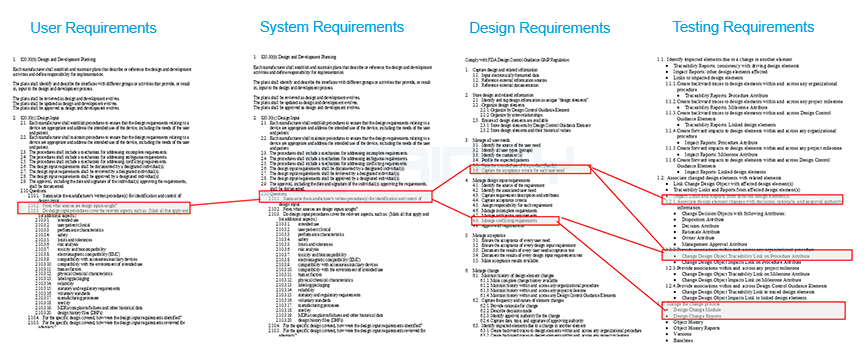What is requirements management?
Requirements management refers to the management and processes related to the collection, definition, analysis, review, organization, maintenance, traceability, and reuse of development requirements for products, systems, or projects. It typically refers to the development requirements for applications or software systems. Requirements management, along with configuration management, test management, defect management, risk management, change management, and other management processes, constitutes the complete process of ALM application lifecycle management. The requirements management process defines and progressively decomposes the entire application's functionality and associated constraints, while managing the traceability relationships between upstream and downstream components as they evolve through iterative development iterations. This ensures consistency between the released product and the original design requirements.
Requirement management is an indispensable part of the system development process. In actual development projects, the work involved in requirement management generally includes:
• Requirement collection and definition
• Requirement import and export
• Requirement decomposition and refinement
• Requirement review
• Requirement release
• Requirement change
• Requirement traceability
• Requirement reuse
• Requirement testing, etc.
Why is requirements management necessary?
Typical projects usually involve a large number of design requirements, especially those with high security requirements. These requirements are listed in various requirements documents, such as product requirements, system requirements, software/hardware/mechanical requirements, etc. If these numerous requirements are not managed, users cannot clearly determine whether the requirements have been met, whether they have been validated by test cases, whether they have been discussed—whether they need to be modified/adjusted—and whether the adjusted requirements have been approved by other teams (e.g., whether there are development/technical challenges). If a project lacks a robust requirement management system and process, the project lifecycle will be extended, and users will not have a suitable platform to view the overall status of the project.
In simple terms, the purpose of requirement management is to establish an orderly traceability relationship based on requirements that spans the entire application lifecycle, ensuring that the final released product does not deviate from the original expectations. Specifically, this is reflected in:
• All upper-level product requirements are not overlooked during decomposition, development, and testing
• No unexpected requirements arise
• Clear change impact analysis ensures synchronization of R&D process information. During the iterative development process, any changes to requirements at any level can be promptly identified, and upstream and downstream requirements are updated and maintained
• Utilizing reasonable review processes reduces the occurrence of erroneous, ambiguous, or unreasonable requirements, thereby lowering the risk of product defects caused by poor requirement quality
Requirement management can be handled by product development personnel using documents such as Word or Excel, or it can be accomplished using existing requirement management tools. However, as business operations expand and product complexity increases, manual management becomes increasingly challenging. A more efficient and effective management approach is needed to achieve orderly requirement management.

Demands and Challenges
-
There are too many requirements at different levels, which may be scattered across a large number of different files or systems and managed by different people. It is extremely difficult to keep this information synchronized in a timely manner without causing omissions.
-
The traceability and maintenance between upper-level requirements and lower-level requirements are relatively difficult.
-
It is difficult to obtain a complete traceability relationship between demand and the outputs of the R&D process.
-
Existing demand management tools are too cumbersome and have too great an impact on the efficiency of the R&D process.
-
Existing demand management tools cannot balance industry compliance standards and enterprise customization requirements.
-
How can a demand management system be deployed effectively in large teams?
Solutions
-
Visure Requirements Management System provides a complete one-stop requirements management solution, covering the entire application lifecycle from requirements definition, import/export, editing, version management, approval, release, change management to test management and risk management, providing a complete solution for full traceability. It solves the problems of inefficiency and unpredictability that may arise from manually maintaining a large number of requirements documents.
-
Utilize Visure Requirements' built-in “out-of-the-box” data models for different high-reliability industry standards to ensure that the requirements management process perfectly complies with relevant compliance standards, covering common R&D standards such as ISO 26262, ASPCE, EN 50128, IEC 61508, DO-178B/C, etc.
-
Supports built-in or custom requirements review processes to meet the needs of different R&D teams' personalized processes.
-
Automatically establish a requirements traceability matrix that covers the entire application lifecycle, including all links between requirements and requirements, requirements and tests, tests and defects, etc.
-
Provides a wealth of built-in report and dashboard templates, and supports customization of demand management reports as needed.
-
Provide plug-ins and API integration with commonly used third-party design, development, testing, and management tools.
-
Visure Requirements offers two deployment options based on C/S and B/S architectures, supporting multiple environments such as Windows, Linux, and MAC, and providing comprehensive user, permission management, and collaboration mechanisms. The platform is easy to use, has a short implementation cycle, and can be quickly deployed by teams.
RELATED RESOURCES









